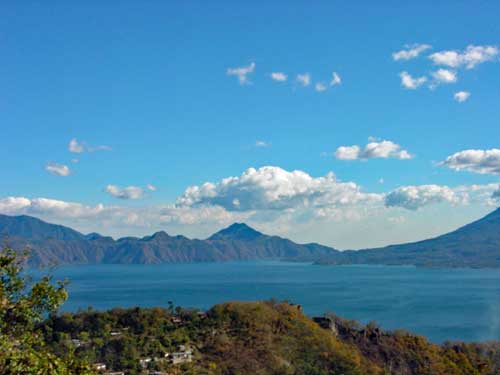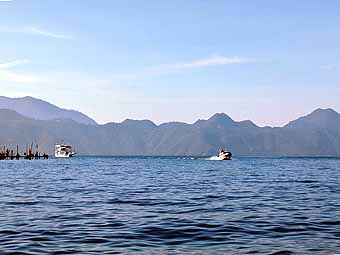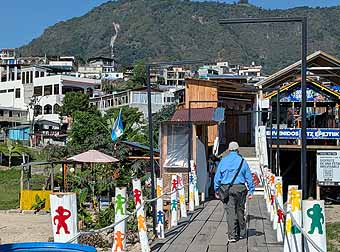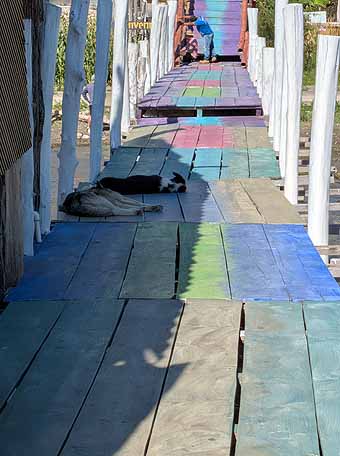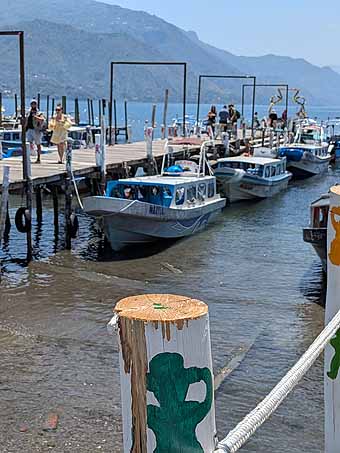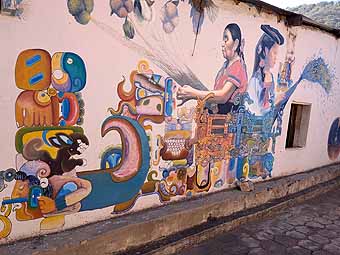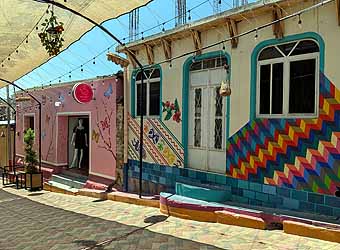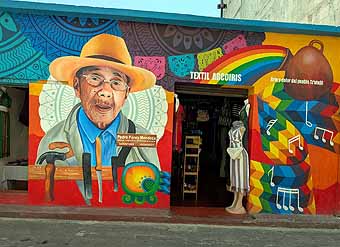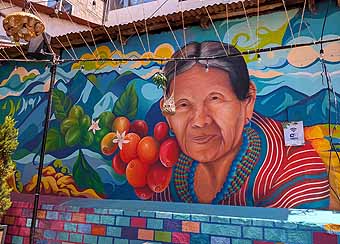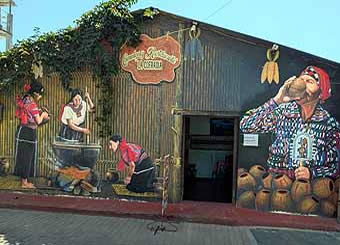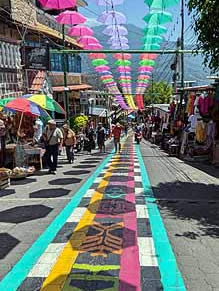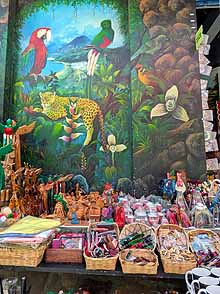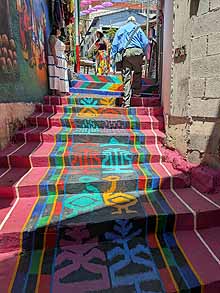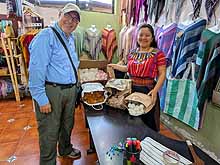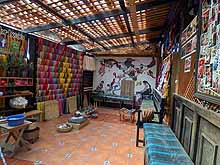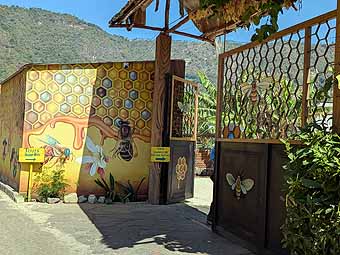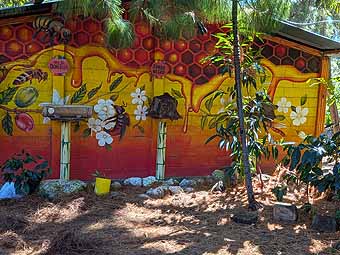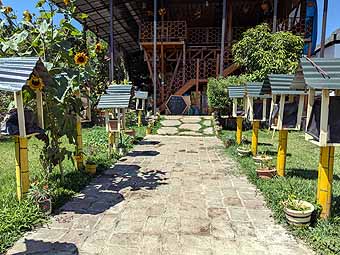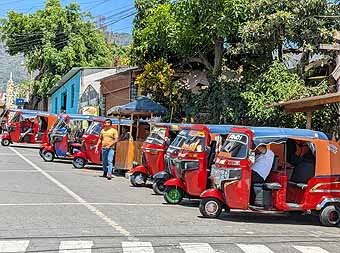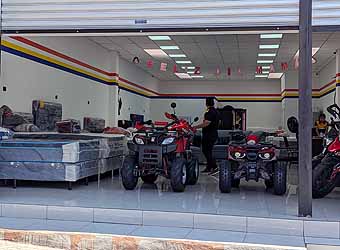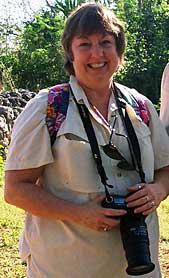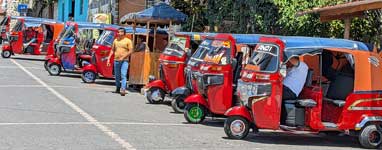 |
|
SAN JUAN LA LAGUNA, GUATEMALA |
|||
Story and photos by Vicki Hoefling Andersen |
|||
About 85,000 years ago in the central Highlands of Guatemala, the Los Chocoyos volcanic explosion discharged over 180 cubic kilometers of hot ash and rock. This was 30 times what Vesuvius blew when it buried Pompeii, and 90 times the eruptive fury of Mt. St. Helens. Left behind was a 12-mile-long by 6-mile-wide water-filled caldera which has been called one of the most picturesque lakes in the world.
Ensconced 5,125 feet above sea level, Lake Atitlan plunges 1,049 feet making it the deepest lake in Central America and one of the deepest in the world. As the depth increases, the color changes from pale turquoise to a deep blue, with underwater currents creating variously hued patterns on the surface. On the southwestern shore, a trio of cone-shaped volcanoes provide a majestic backdrop. Volcan Atitlan towers 7,868 feet above the lake and is considered dormant but “fumarolic” having last erupted in the mid-1850’s. Toliman rises 6,228 feet above the lake and San Pedro 4,917 feet. Both are regarded as extinct. Thirteen small villages cling to hillsides and sprawl up ravines around the shoreline. This region has the highest concentration of indigenous Maya and is one of the richest in traditional customs, dress, lifestyle and livelihood. I immerse myself in the views and contemplate the history as our lancha, or water taxi, departs the lake-front town of Panajachel towards the far western shore, to the foot of Volcan San Pedro and the village of San Juan La Laguna.
Lake Atitlan and some of its docks
Water taxis are an easy way to explore the villages around Lake Atitlan. Cheery docks greet visitors arriving in San Juan La Laguna, one of the smaller towns. Colorful walkways at the dock are a breezy place for four-legged locals to get some snooze time. Lanchas deliver locals and visitors to San Juan La Laguna. When exploring the Lake Atitlan area, water taxis are relatively easy to use, inexpensive, and are utilized by both tourists and locals. Some are more “express” routes to just one or two destinations (direct from Panajachel to San Juan La Laguna took about a half-hour), while others make stops at numerous villages. The population of San Juan La Laguna is about 95% Tz'utujil, one of 21 Maya ethnic groups. Local law prohibits outsiders from purchasing land within the municipality so it hasn’t experienced the influx of expats who’ve bought first or second homes around the lake. The atmosphere is authentic charm within a framework of a strong traditional culture. The town’s mainstay was agriculture - mainly avocado, coffee,
These murals and painted storefronts on Avenida 5a pay homage to the process of weaving and to many of the patterns incorporated into local textiles. As the twentieth Century segued into the twenty-first, the people and town were ready for a transformation. The women formed a co-operative to market their handicrafts, and by 2020 they had developed a network that sells their goods all over the world. The town resolved to promote itself as a cultural and artistic destination and has become world-renown for its dazzling art studios and galleries, inviting cafés, and particularly for its “Museo de Cielo Abierto” or open-air museum of vibrant and expressive wall murals and colorful streets. Most pedestrian-friendly is Avenida 5a, where murals painted by young artists from “Jovenarte” honor their cultural heritage and identity using traditional painting techniques and images. Some depict everyday Tz’utujil Maya life or scenes rich in Tz’utujil symbolism, while others honor specific figures. Hundreds of murals adorn the walls and streets of San Juan La Laguna.
Avenida 5a
Pedro Perez Mendoza, a musician, carpenter and artistic designer, is among local residents (including a mayor, a talented musician and a midwife) who are memorialized in murals. All facets of everyday life are portrayed including preparing and enjoying food, and harvesting coffee berries. Some streets are festooned with hats, umbrellas or dolls. On Calle del Sombrero, aka “Sombrero Street,” you’ll find colorful straw hats shading the light bulbs. The main street guiding visitors from the boat docks into town is Paseo de las Artes or “Way of Art” whose roadway is a kaleidoscope of designs and colors.
Paseo de las Artes is so striking you almost hesitate to walk on it while browsing local offerings of quality handicrafts. Even the steps leading to small art galleries are adorned with vibrant hues. There are a couple of textile co-op stores that offer demonstrations of how they grow and harvest cotton, prepare and spin the fibers, and use dyes made from the bark, root, leaves, flowers and seeds of local plants to give the threads their brilliant colors. Visitors can watch and even have a chance to try weaving cloth on a traditional Maya backstrap loom. Woven goods of all sorts are available for purchase. A nice human touch - each item is tagged with the name and photo of its creator.
My long-time friend and guide Alfonso and his wife, Diana, grow various colors of cotton in their Guatemala City garden. After harvesting, they donate it to the Casa Flor Ixcaco Textiles co-op, whose exhibition room invites exploration even if no tours are in progress. Bee-keeping and honey production among the Maya dates back around 3,000 years. Two apiaries, where beehives are kept, offer complimentary tours and a chance to learn about these important pollinators. Honey was used in religious ceremonies, for medicinal purposes, as a sweetener, and to make an hallucinogenic honey mead called balche. Guatemala is home to at least 33 species of stingless bees, and the Maya even have a god, Ah Mucen Cab, dedicated to protecting bees and honey.
Mundo de Abeja’s Mayas
At Mundo de Abejas Mayas, “Maya the Bee World,” you can see different species of bees, various types of hives, preferred sources of pollen, and learn how honey is extracted from the combs. There is a lot to discover in San Juan La Laguna including cacao and coffee tours, and a couple of locations where you can learn about medicinal plants used by the Tz’utujil Maya. On a towering outcrop above town is Mirador Kaqasiiwaan, aka Mirador Cerro de la Cruz, with a view of the three volcanoes and settlements along the nearby shoreline. If you really want to pump those legs, scenic hiking trails scatter in all directions.
Ubiquitous tuk-tuks make it easy to explore San Juan La Laguna. In the heart of town is a one-stop-shop for a new bed, or 4-wheeler ATV, or motorcycle. It had been 23 years since I last visited Lake Atitlan and I wondered how much it might have changed. My take-away: it’s even better now. The people are still friendly and easy-going, it’s uncomplicated getting around, you can survive with a meager vocabulary of Spanish, and it’s still a hub for distribution of handmade crafts from all over Guatemala. Accommodations come in all types and budget levels, and the diversity of cafes, restaurants and food stands will delight your taste buds. Don’t wait a quarter-century to discover it for yourself. About the author:
|
